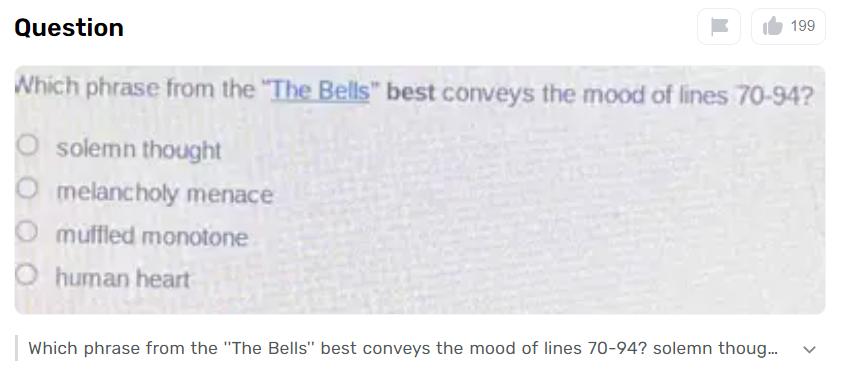The sonnet The Bells by Edgar Allan Poe is a breathtaking glance at sound and feeling. It is divided into four sections that demonstrate various bell types and the moods they evoke. From the blissful silver bells to the serious iron chimes, Poe handily utilizes language to bring out a scope of sentiments.
This segment fills in as a defining moment in the sonnet, moving from the mellower tones of the prior chimes to a more frenzied and disrupting climate. Let us explain the query: which phrase from the “the bells” best conveys the mood of lines 70-94? The imagery and rhythm Poe uses in this section are so potent that it warrants a more in-depth look, particularly to determine which phrase best conveys the mood.
What is the Overview of Poem, The Bells?
There are four sections in Edgar Allan Poe’s striking poem “The Bells” that are each devoted to a different kind of bell: iron, brazen, golden, and silver. Utilizing clear symbolism and cadenced stanzas, Poe portrays an excursion through life’s stages, from energetic delight to the seriousness of advanced age and passing.
Each ringer type represents different close-to-home states as well as summons particular hearable and visual sensations, catching the peruser’s creative mind through Poe’s breathtaking control of language and sound. The bells hence remain a demonstration of Poe’s wonderful virtuoso, displaying his capacity to mesh together tangible encounters and existential subjects into a strong and profoundly reminiscent work.
Analysis of Lines 70-94
Lines 70-94 of Edgar Allan Poe’s “The Bells” mark an emotional change in tone and symbolism as the sonnet advances from the serious ringing of iron chimes to the excited alerts. Poe expertly employs language and rhythm to convey urgency and chaos in this section.
Poe’s ability to convey profound emotions and sensory experiences can be appreciated through an in-depth analysis of these lines. This makes “The Bells” more than just a poem about sound; it is also a profound investigation of human emotions and existential themes.
Identifying the Key Phrase
The structure, rhythm, and thematic significance of the key phrase in Edgar Allan Poe’s “The Bells” must be carefully examined, with particular attention paid to lines 70-94. “What a tale of terror, now, their turbulence tells!” is one of the powerful lines that describe the alarm bells. arises as the significant expression catching the embodiment of dread and bedlam.
This phrase encapsulates the unsettling nature of the alarm bells ringing with its vivid imagery and emotional intensity. The use of words like “terror” and “turbulency” by Poe not only emphasizes the tumultuous atmosphere but also the bells’ narrative quality, as if they are telling a terrifying story.
Gauth As Best Question Solver
Here are the steps to use Gauth as the best question solver:
Step 1: Access Gauth
First of all, you have to access the official website of Gauth where you will be able to do all your work.
Step 2: Type Your Question
When Gauth is launched, a user-friendly interface will allow you to type in your question. Simply express your question in the app in a clear and concise manner, regardless of whether you require assistance with academic inquiries, questions about problem-solving, or general knowledge queries.
Step 3: Go To Free Trial
Gauth lets users try out its question-solving capabilities for themselves with a convenient free trial. After composing your inquiry, continue to choose the “Free Preliminary” choice inside the application. This step starts with Gauth’s intelligent processing system, which quickly looks into your question to give you an accurate and useful answer.
Step 4: Get Response
Gauth promptly provides a response based on its extensive database and sophisticated algorithms once you have submitted your inquiry and selected the free trial. The app makes use of cutting-edge artificial intelligence to guarantee that the information it provides is pertinent, trustworthy, and tailored to effectively address your query.

Final Wording
Edgar Allan Poe’s exploration of sound and emotion in “The Bells,” particularly lines 70-94, demonstrates his mastery of evoking language and rhythmic intensity to convey the turbulent mood. The expression “What a story of fear, presently, their turbulency tells!” stands apart as the best in conveying the feeling of dread, earnestness, and disorder exemplified by the alerts in this segment.

